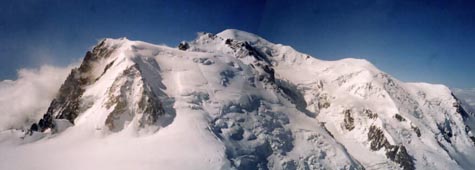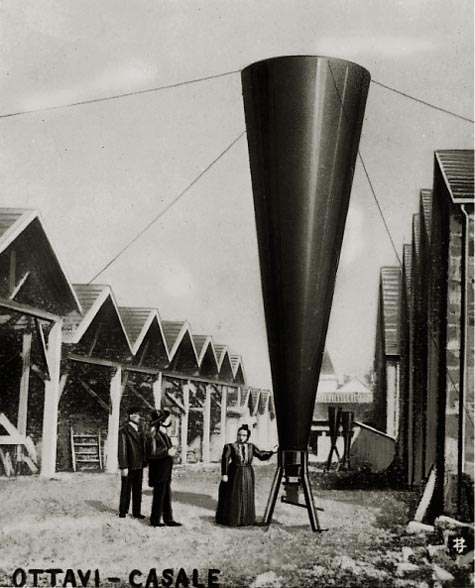The Weather Emperors
 [Image: From Blend, a Dutch magazine for whom I wrote a monthly column from January 2006 to June 2007].
[Image: From Blend, a Dutch magazine for whom I wrote a monthly column from January 2006 to June 2007].One of the most interesting—if unexpected—side-effects of global climate change is that the Alps are growing taller.
According to New Scientist, warmer temperatures have been causing those mountains to "shed the weight of their glaciers," with the result that "the unburdened crust beneath them is rebounding, causing the mountain range to rise slowly."
Mont Blanc, for instance, "where the melting is fastest, is growing by as much as 0.9 millimetres per year due to climate change."
Less than one millimeter per year isn't much, but these deep and shuddering geological adjustments are exhibiting effects elsewhere—such as increasing the rate of seismic activity throughout the Alpine region (with the mountains themselves literally shattering as old faults decompress). Amazingly, this Alpine growth spurt has actually begun to alter wind patterns flowing across the greater European landmass.
In other words, the weather will begin to change yet faster—feeding back and changing the very tectonic structure of the continent.
 [Image: Mont Blanc].
[Image: Mont Blanc].Meanwhile, in other climate news, cities—and this is obvious to anyone who has ever set foot in one—are hotter than the surrounding countryside. This difference can be as much as 10ºC, New Scientist reports. The built environment simply absorbs more heat than the surrounding landscape, with roads, freeways, car parks, roofs of buildings, etc., all baking slowly in the afternoon sunlight.
This is the appropriately named urban heat island effect.
From New Scientist:
- ...bricks, concrete and asphalt absorb more heat than vegetation – and fewer trees means less shade. The effect is strongest in high-rise areas, where the heat-absorbing surface area of buildings is vastly greater than that of the natural landscape they replaced. Add to this the heat thrown out of buildings by air conditioning systems, and generated by cars and factories, and the result can be sidewalks hot enough to fry an egg. The difference is usually even greater at night, as buildings hold onto their heat far longer than fields or woodland.
This means that strange weather, including extra rainfall and more violent thunderstorms, can be expected "up to 60 kilometres downwind of cities such as Dallas and Atlanta"—not to mention cities like London, Paris, Venice, Sydney, Tokyo, and so on.
So if it's raining in your home town tonight: blame the nearest city.
Which leads me to wonder: is there a particular patch of sea somewhere outside New York City where the winds are stronger, or the waves more violent, or the rain more extreme—and it's all of because of the complex downwind effects of Manhattan...? Does New York have a climatic presence in the north central Atlantic?
The city as a kind of storm valve, regulating weather for distant ships...
 [Image: The topography of the Alps].
[Image: The topography of the Alps].In any case, putting these two bits of news together, perhaps we could build something—a structure or some sort of device—that would take advantage of both Alpine growth and excessive urban heat.
If we combined these two stories, for instance, a new kind of military tactic takes shape: you build strange, fortified, geologically monumental weather-affecting landscapes all over the world – and then destroy distant targets downwind.
The Thames Estuary could be lined with a series of heated platforms—large towers, like ovens—pointed toward Europe. This artificially generated microclimate would then be weaponized and run by the British military, who would lay claim to the weather itself. Amsterdam could be washed away in a fortnight, Paris held hostage for years. Or perhaps an armada of heated ships could be sent to the South China Sea... and Beijing becomes servant to the Queen. China’s soldiers will be blown over as umbrellas are inverted throughout the country, and the nation’s stock of nuclear missiles is redirected north, by wind, into the thawing wastes of Siberia.
It would be the world's first air weapon, shooting bad weather on demand.
 [Image: A hail cannon, via a website about weather modification. For a bit more on hail cannons, see BLDGBLOG's Quick list 7 (scroll down)].
[Image: A hail cannon, via a website about weather modification. For a bit more on hail cannons, see BLDGBLOG's Quick list 7 (scroll down)].On another note, I read several years ago about an Australian home-owner who once found strange and unexpected flowers blooming in the family garden. These were flowers that he'd never seen before—and that he'd certainly never planted—so what soon became clear was that a drought on the other side of Australia, coupled with unseasonably strong winds, had blown seeds and a thin mist of soil throughout the country... some of which had come to settle in this man’s garden.
He was a victim of the weather, botanically vandalized.
Perhaps, then, instead of unleashing storms upon distant opponents, you could convert the air weapon to a more useful, peacetime purpose: horticulture. Gardens at a distance.
You'd throw exotic seeds into gathering breezes—and, within weeks, distant hillsides would color and bloom with breadfruit and roses, berries and genetically modified knotweed. Shift the direction of the wind and a hundred miles of orange trees take root, forming orchards; shift the wind yet again, and uncountable acres of lavender, mint, rosemary, white pine, and birch appear, as you reforest the world from afar.
So, as the Alps grow taller and as continental wind systems shift, perhaps we’ll find that the balance of power in Europe shifts upward.
 [Image: Chimneys, via Wikipedia].
[Image: Chimneys, via Wikipedia].There, on the slopes of snowless mountains will sit strange ovens in towers, blowing both weather and seeds over the horizon of nations below. Amidst angled platforms and wind-ramps, a new breed of rulers grows strong, distributing gardens and thunderstorms upon those countries they now dominate.
The Weather Emperors, ruling Europe from above.
Until a small group of irritated gardeners, congested with allergies and choking on seeds, begins to climb up the Alpine front, intent on liberating their countrymen from this artificial weather. They haul themselves through rocky passes and eat rare Peruvian fruit that now grows freely in Swiss crevasses. They pull each other up toward the storm machines, those great chimneys spewing unwanted landscapes upon the flatlands of central Europe.
The rebels approach the nearest tower, hammers raised.
(Other articles written for Blend include Urban Knot Theory, Abstract Geology, Wreck-diving London, and The Helicopter Archipelago – and there will soon be many more, reproduced here on BLDGBLOG. Meanwhile, I can't find the original articles that I'm quoting in this essay; till I find the appropriate citations—sorry!—here's a bit more on the post-glacial growth of the Alps).





Comments are moderated.
If it's not spam, it will appear here shortly!
i can't help being reminded of the article in cabinet from several years ago about the high line in new york city. it is (was) blooming with tons of foreign plants, the seeds for which were inadvertantly carried by the wheels of the trains making deliveries to new york from other parts of the country. imagine if the trains could bring non-local climates with them, as well, speaking of transporting weather?
[ thanks for the v. interesting post. hope to talk soon.
L ]
I always wondered what might happen if we laid asphalt across the entire backside of the San Gabriel Mountains... Would the rising heat literally "suck" all of the smog out of LA ??
I think that Gehry is working on his new Empire in LA...
http://www.npr.org/templates/story/story.php?storyId=4541963
there was a great Engineering Disasters show on the History Channel about this. apparently the condos experienced 4x the normal cooling bills, and the sidewalk got to 58C.
Post a Comment